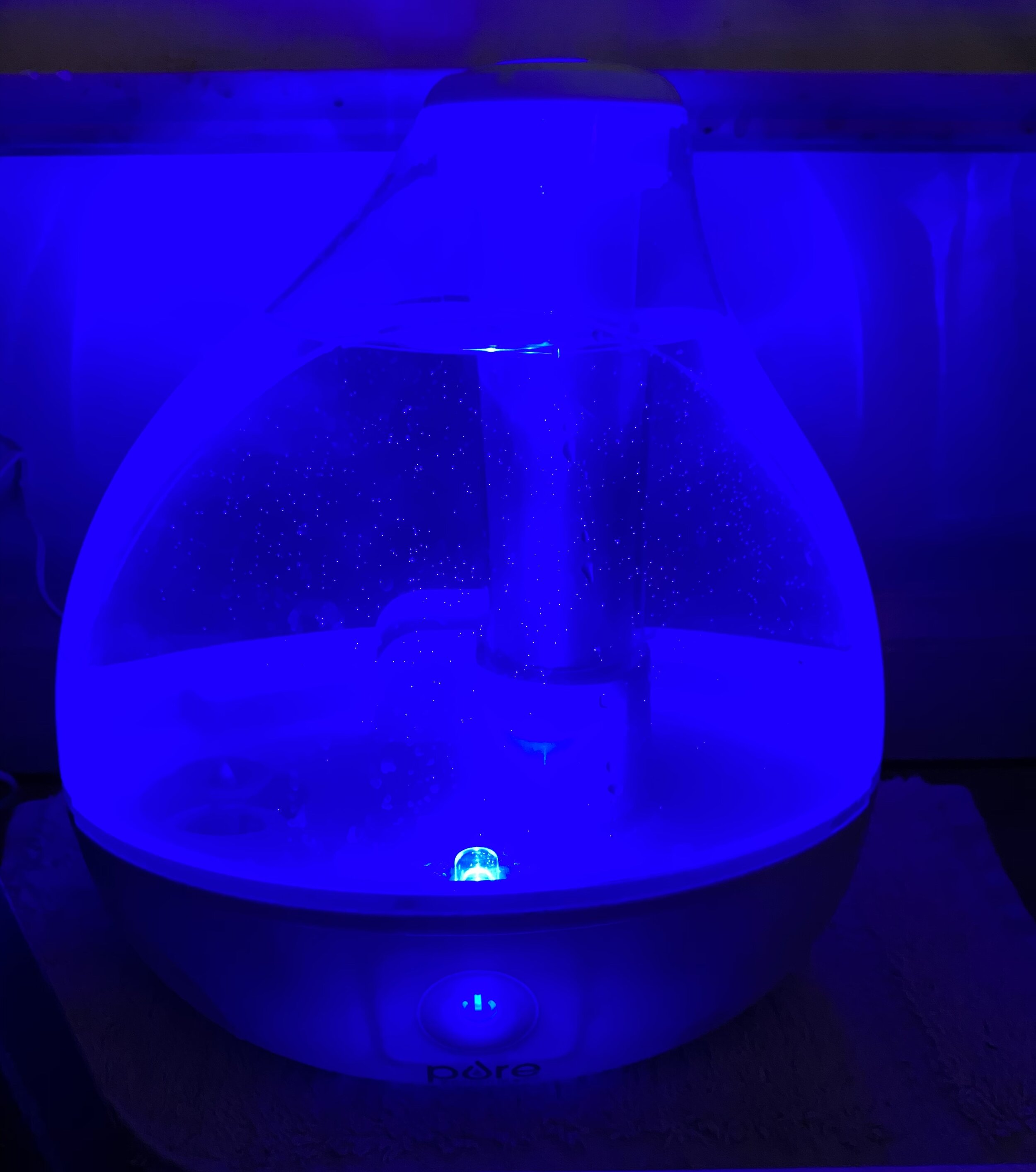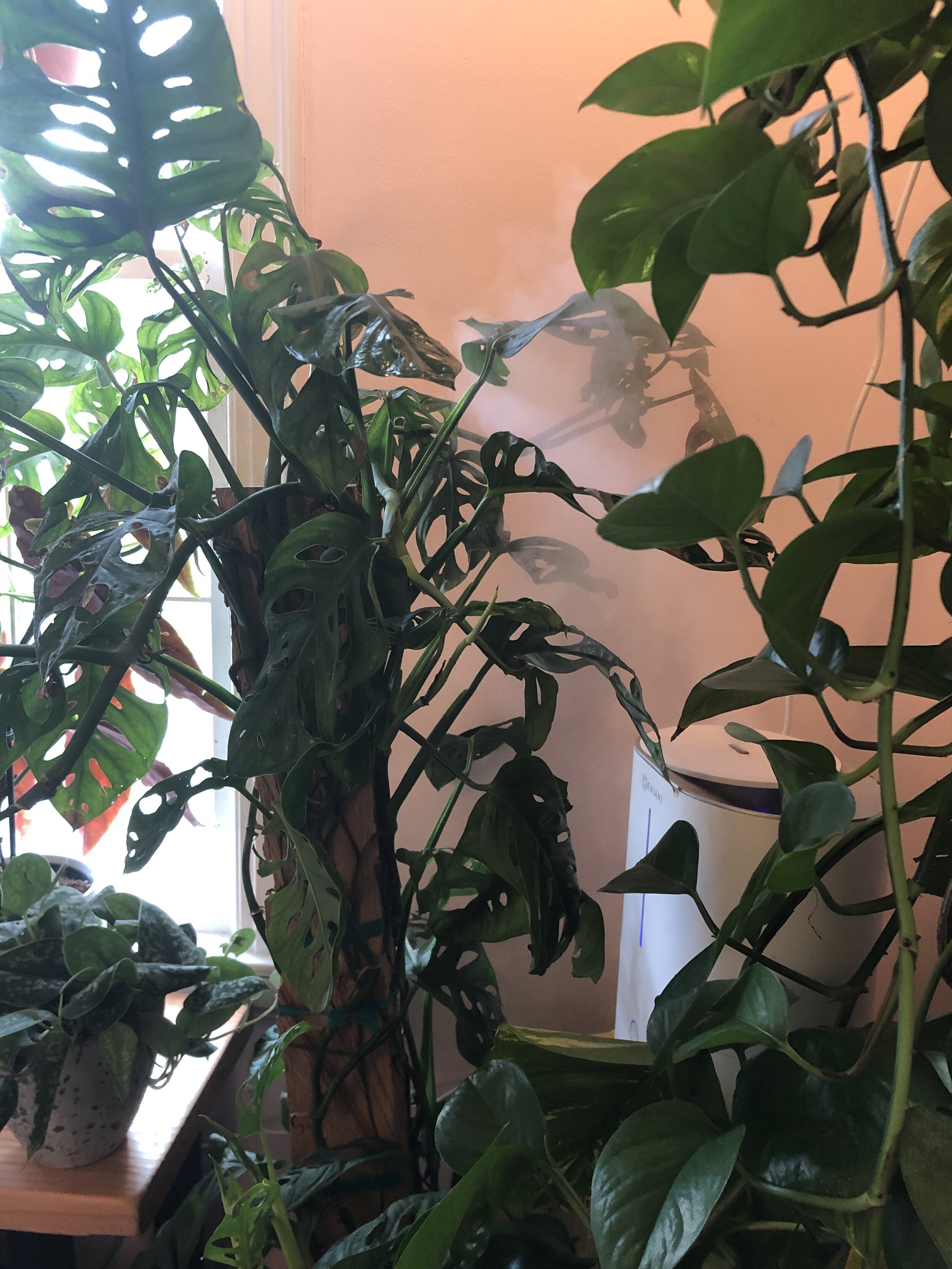
Humidifiers.
There’s debate in the houseplant world about the necessity of running a humidifier. Monstera Adansonii, for example, really thrives with the extra humidity. Aglaonema in my home, on the other hand, don’t really seem to mind if it’s there or not. This all goes back, of course, to the native environment of each plant we’re keeping in our home. Many plants thrive in the dense jungles of Central and South America where the humidity helps epiphytic plants hydrate, feed, and grow.
The EPA recommends a household humidity level of 30-60% to help combat unwanted household invaders like mold. Being a houseplant enthusiast, however, provides a different reason to monitor humidity levels. Plants feel most comfortable with the levels being around 50%. It might be necessary to add a few wetter spots in the house where smaller humidifiers (designed to accommodate ~250 square feet) cater to plants with more specific humidity needs. True, clumping plants closely together helps take advantage of their natural transpiration, but humidifiers can really make the difference in the thick of winter, or for those who live in an arid environment. Want to know why plants need humidity? Read on. If you’re already in the know, skip ahead to the humidifiers!
Why do Plants need Humidity?
Plants breathe a lot like humans do. Humidity is an important element in any plant’s breathing process. They inhale Carbon Dioxide, which is great for us since we produce so much of it, unfortunately. Plants also transpire, or sweat, like people do. When they open their pores to take in Carbon Dioxide, they transpire at the same time - kind of like when we breathe against a window or mirror. When we exhale, the surface is fogged by the moisture from our breath. Then our inhalation occurs, but by the time we exhale again, the surface is barely clear from the last exhalation. This transpiration causes plants to lose water throughout their systems, which can cause dehydration that’s detrimental to the plant’s well-being. The plant can look dull or droopy, but it wont’t recover its perkiness after you water the plant. In environments that are especially dry, plants can lose water through their leaves faster than their roots can safely absorb it. You could water and water your plant, but it wouldn’t replenish the moisture in the foliage. In fact, you’d most likely end up causing root rot in the plant. Plants like Epiphytes depend on the moisture in the air not only for hydration, but also to provide them with nutrients that they don’t get from their unique root systems.
You can help your plant be its best healthy self by providing adequate humidity - check with a humidity meter if you’re unsure of your levels. Misting is a great way to freshen up the foliage, and it’s easy to do! Plants love wet foliage every so often because they’d be experiencing rain in their natural environments. It’s only natural. A leaf bath in the sink is a great choice once a month or so. It’s great to employ your monthly plant shower when your plant is already due for watering, that way it isn’t over-watered inadvertently. A leaf bath or shower helps remove any residue, dirt, pet hair, or dust that has accumulated on the leaves from regular household conditions. These obstructions can prevent the plant from its process of inhaling and transpiring. Removing them regularly saves your plant from effectively suffocating over time. Another area to watch is the kitchen. Plants that live near the cooking area might love that heat and humidity, but cooking oils and residue can settle on the leaves, so bathing or polishing those leaves can help a lot. Trust me, I’ve lost more than one cooktop adjacent plant in my day.
On to the Humidifiers!
Geniani Top Fill Cool Mist Humidifier.
I got this humidifier on Amazon.com. The features that appeal to me are the convenience of pouring water directly in the top of the unit, the calming blue light, and, should I ever need it, the ability to diffuse essential oils along with the water. It does run a full 24 hours on the lower setting, and it puts out a great amount of humidity and I’m really happy with the performance overall.
Pure Enrichment MistAire Ultrasonic Cool Mist Humidifier - 1.5 Liter
I was drawn to Pure as a brand because the warranty is so appealing. It’s 5 years warranty if you register the product, though I’ve never had a problem in the year plus that I’ve owned it that would be cause for alarm. This humidifier is small, but it lives in my bathroom where it provides humidity for my Hoya between showers. For that small space, it’s perfect and the blue light also works as a nightlight. It has a low and a high setting, though I only ever use the low setting and it gives 24 hours + of humidity for my plants.
Pure Enrichment MistAire Ultrasonic Cool Mist Humidifier - Premium Humidifying Unit
I bought this humidifier because I liked the other Pure unit so much and again, I was impressed by that warranty. This one has been just as reliable as its counterpart, and it humidifies the plants in a small nook in my bedroom. It also has two settings, but I keep it on the low setting and adjust the nozzle every day or so to ensure everybody is getting their fair share.
Safety 1st Ultrasonic 360 degree Cool Mist
Humidifier
I got this humidifier ages ago, years ago. I love the 360 degree feature, it helps the humidifier reach a larger area. About a year ago, the original humidifier malfunctioned and I was suddenly left without humidity for some of my plants. I contacted Safety 1st and was so thankful for their amazing customer service. I just wanted to order a part so I could repair my humidifier, but they replaced the entire unit for me! Highly recommend for plants and humans.
LEVOIT Humidifier
Let me start by saying that I do not own this humidifier. I have seen it highly recommended by other houseplant enthusiasts and I have considered buying it simply based in their experience with the product. If I should find myself in a place where I need a larger model of humidifier, I’m looking at this one.
Side Note: It’s Best to Be Sure…
Testing your household humidity with a humidity gauge can give you a good idea of where you are and where you need to be. Each plant has different needs, but most plant fiends have purchased (or will purchase) a plant with special humidity needs at some point in their plant fiend career. You’ve got to keep tabs on these high humidity plants, and a humidity gauge will help. I’ve been tempted to skimp in the past and purchase the dirt cheap multi-pack of gauges, but through trial and error, I’ve learned that it’s best to purchase a good gauge for the areas of your living space that will be housing plants with high humidity needs. Check out some gauges below for more info.
ThermoPro Digital Hygrometer.
I love the ease. You have temperature, humidity, a little comfort indicator (which is subjective, I suppose) and highs and lows. I like the high and low features because it’s nice to know how much of a difference my humidifiers are making, and I can test this by keeping an eye on the humidity high and low block.
Veanic 4-Pack Mini Digital Meters.
For those of you who want to buy a multi-pack and stick them to every wall - no judgement. I’ve been there, I’m still sometimes there.








